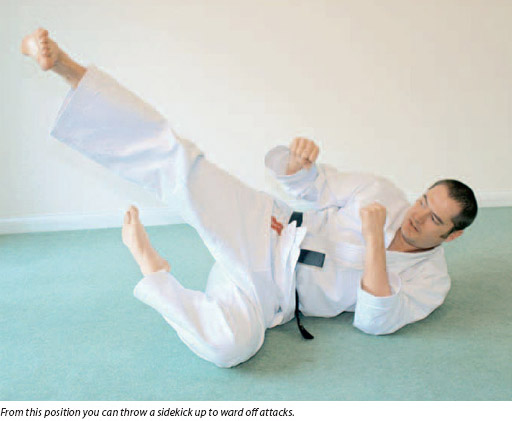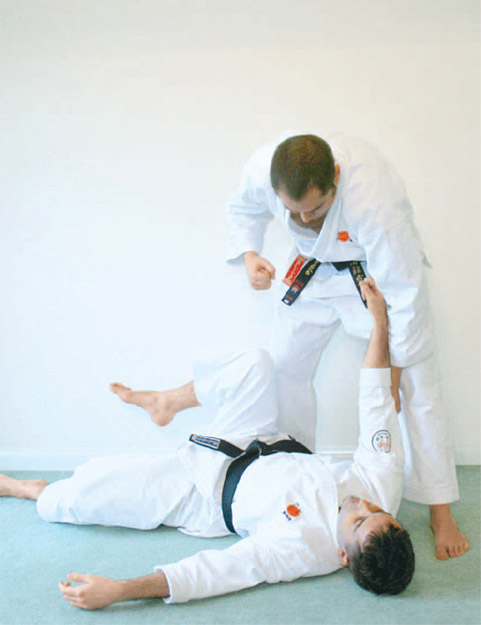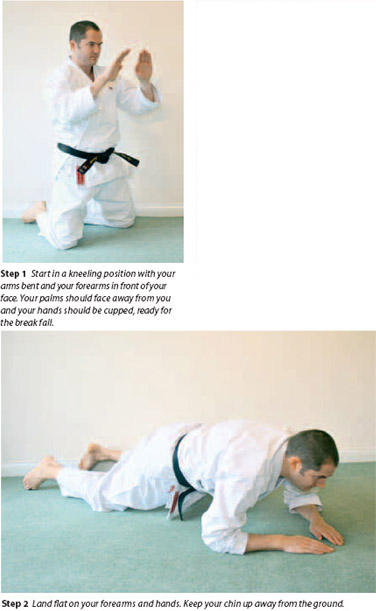
Never interrupt your enemy when he is making a mistake.
~ Napoleon Bonaparte
Break Falling
Break falling is the art of landing while minimizing how much you get hurt. This is an essential skill for a martial artist wishing to practice any throwing skills or take downs with a training partner, because without effective break falling skills, practicing these techniques in anything like a realistic manner would quickly result in injury. Break falling is also a useful everyday skill because it can be used when you fall for whatever reason.
Falling isn't the problem; it's hitting the ground that does the damage. The body's natural instinct is to put out a hand to break the fall, but this will focus all the energy of the fall into that arm and can result in a broken wrist or even a broken collarbone as the energy is transmitted up the arm to the shoulder. Break falling techniques aim to override this instinctive reaction, by training you to spread out the impact of hitting the ground. Positioning the body so that the impact occurs on a surface of the body that is as big and as flat as possible does this.
It is useful both inside and outside the martial arts training environment. In training, it can be used to recover from throws and also to get out of awkward holds. In everyday life, it can help you react effectively when you slip or fall. Break falling training, like all martial arts, is all about building up a reaction to a particular situation. You should learn to gain control over your instincts to hold out your hands as you fall and instead to prepare yourself to impact the ground with as much of the fleshy part of your body as is appropriate for that particular kind of fall.
This chapter looks at falling forwards, backwards and sideways. It also presents ways to elegantly recover from the fall by rolling through techniques. Practicing break falling should always be done in an appropriate environment with the right equipment. Otherwise, the training itself can be dangerous.
| SUMMARY OF BREAK FALLS | |
| Front break fall | Useful for falls where you go directly forwards and don't have time to perform the front rolling break fall. |
| Back break fall | Useful for situations where you fall or are thrown directly onto your back. |
| Side break fall | The most practically useful break fall. This can help you to recover from many martial arts throws. |
| Front rolling break fall | Can be useful as part of a routine to get out of a lock or hold or when you are thrown forwards. |
Break Falling Myths
Break falling doesn't hurt. - Of course it does. Repeatedly throwing yourself on a mat or a hard surface is bound to cause some aches and pains.
Knowing how to break fall means that I will never get hurt when falling over. - Break falling correctly should help to reduce the risk of injury, but it certainly doesn't mean that you will always walk away completely unharmed.
Break falling means I am safe. - It is fine in a controlled environment, where you have mats, the surface is even and clean. However, if you take a look around outside of this environment, it is a completely different situation. Raised surfaces, walls and objects are all examples of things you will commonly find that are likely to make break falling more dangerous.
How about falling from a height? - Break falling mostly works from ground level. The further you fall, the greater the risk.
Training tips
1. Start your break falling training using thick, supportive mats.
2. You should relax your arms and torso while performing break falls. The more you tense up, the more you are likely to hurt yourself or to perform the break fall incorrectly.
3. Your hands should be cupped.
4. Hold your head in tension away from the direction of the fall.
5. Maximize the surface area of your body that makes contact with the ground at first impact.
6. Aim to use fleshy parts of your body to break the fall, like your thighs, and not your bony parts, like your elbows or spine.
7. Slap the ground hard at the point of impact.
8. Gain control of your instinct to push your hands or elbows out to break your fall.
Martial arts like judo or jujutsu that routinely use takedowns will teach students break falling techniques at an early stage. In the striking arts, like karate or taekwondo, break falling is sometimes taught but it is usually not a core part of any training program. It's quite common for advanced students in these types of martial arts to never have had any formal training in break falling. However, break falling training is an important skill for these martial artists particularly if they take part in free fighting where trips are allowed. It is important to remember that although the striking arts emphasize strikes over throws and the scoring systems in their competitions bias against throws, usually throws are not precluded. For example, the World Karate Federation (WKF) competitions award points for successful throws (although you rarely see anyone attempt one) and traditional karate kata are positively littered with self-defense combinations designed to throw or trip an opponent (though many practitioners do not realize this).
Always practice break falling on a soft surface, for example, judo mats provide adequate cushioning for break falling. You know when you have completed a break fall successfully, as you will only hear one sound, as you impact the ground all at the same time. If you make more than one sound then you know that your technique needs more work. Break falling doesn't mean that you won't get any bruises and indeed repeated break falling may hurt afterwards. The idea is to minimize the risk of a more serious injury, like a bone fracture or break. You should always try to keep your head tucked in and your hands should be cupped as they make impact with the ground. An explanation sometimes offered is that the air captured in your hands is provides some cushioning to the fall. However, a more reasonable explanation is that it simply engages muscles in the hand and protects the smaller and more fragile bones of the fingers.
FRONT BREAK FALL
This break fall uses the forearms to absorb the impact of the fall. This technique is particularly important in judo where competitors will intentionally try to fall on their front and so avoid landing on their back, which would result in their opponent scoring a point. Ideally, you would want to roll out of this fall using the forward roll. However, there are occasions when that may not be possible and this break fall is useful for those times.

BACK BREAK FALL
The ability to fall backward safely is a useful skill, both in a martial arts and a general context. Leg sweeps and slips in everyday life could leave you falling backwards. The temptation as always is to either push your hands or your elbows out underneath you. Even worse, unless you hold your head tightly to your chest during your fall, as a trained break falling student should do, you may find that because you are not tensing those muscles, your head flops back and may hit the ground with some intensity. The back break fall technique is shown here from a seated starting position. However, it is possible to use the same technique when starting from a standing position. Your aim would be to first get yourself into the seated starting position shown from standing and then to continue with the break fall as normal.
Break Fall
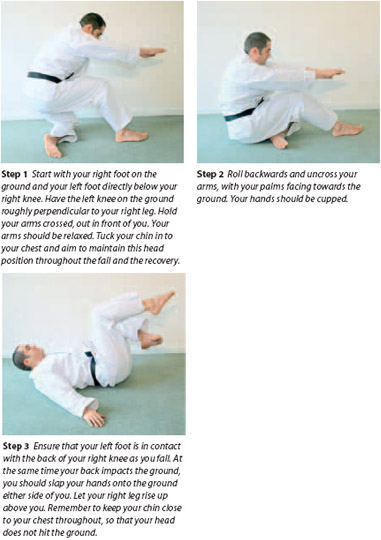
Rolling out can be used to recover from a backward fall. Your aim is to continue using the momentum of your fall to turn you over and to right yourself back into the starting position. This aspect of break falling is emphasized in martial arts like jujutsu and aikido where exercises involve flowing with the technique. In judo and MMA, this kind of move is less common because your opponent is expected to be holding you as you fall, preventing this sort of recovery.
Recovery
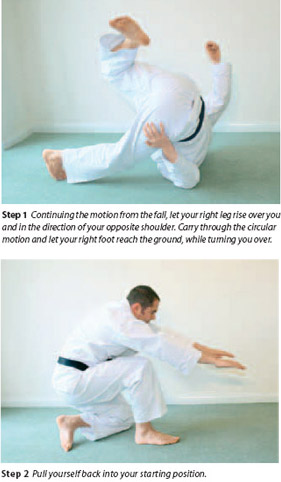
SIDE BREAK FALL
If you are thrown, then chances are that you will fall on your side. This is by far the most common break fall that is needed to recover from throws in, for example, jujutsu and karate. During this exercise, you want to avoid putting too much pressure on your hips as you impact the ground. You want to impact with as wide and fleshy a surface area as possible. The temptation again will be to stick on your hand or your elbow. This must be avoided, as even if you are training on mats, this will hurt. Remember, you also want to hold your head in as firmly as possible to avoid any whiplash. The recovery from this fall uses a roll to the side.
Break Fall
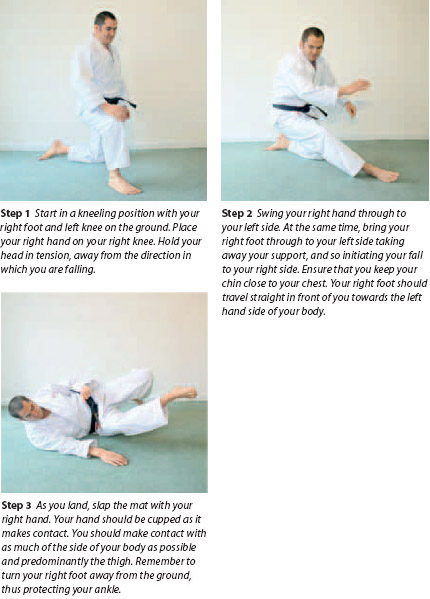
Recovery
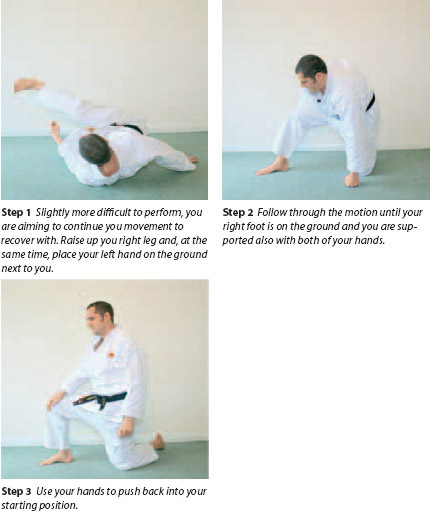
FRONT ROLLING BREAK FALL
The rolling break fall is an alternative to the front break fall and tends to lead to a softer fall because it allows the user to spread the impact out over the duration of the fall. This fall should be used when you are thrown forward. It can also be used to blend with a wrist or elbow lock (this is a common practice in aikido) and roll with it. This break fall is often seen in martial arts movies and can look really impressive, even when the stuntman is completely cooperating with the throw.
It is important to note that this break fall is not like a forward roll that is often taught in gymnastics. In the latter version, you would roll using the top of your head, or the back of your shoulders and then along your spine, along the centerline of your body. Your feet would also remain together as much as possible throughout the roll. In the break fall, you should make minimal contact with the ground using your spine. The roll will draw a line diagonally across your back from the back of your shoulder to the opposite hip.
Break Fall
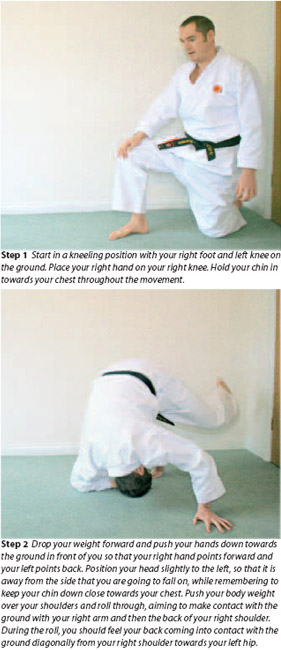
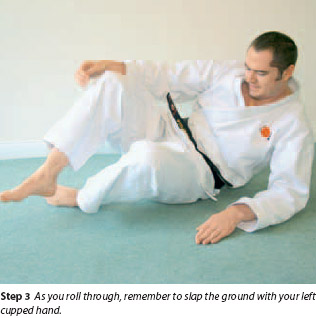
Recovery

